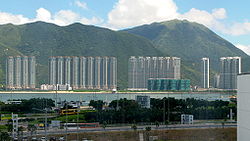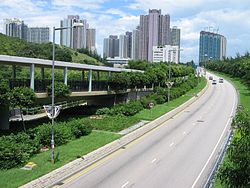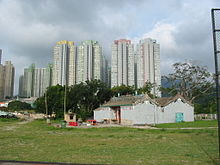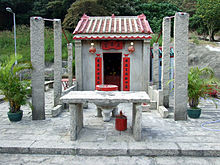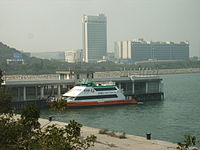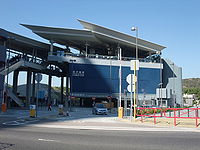- Tung Chung
-
Tung Chung Traditional Chinese 東涌 Simplified Chinese 东涌 Transcriptions Mandarin - Hanyu Pinyin Dōngchōng Cantonese (Yue) - Jyutping dung1 cung1 - IPA [tʊ́ŋ tsʰʊ́ŋ] Coordinates: 22°17′13″N 113°56′37″E / 22.28694°N 113.94361°E
 Location of Tung Chung in relation to the rest of Lantau Island
Location of Tung Chung in relation to the rest of Lantau Island
Tung Chung, meaning 'eastern stream', is an area situated on the north-western coast of Lantau Island in Hong Kong. Tung Chung, currently one of the latest generation of new towns, was formerly a rural village around Tung Chung Wan, and along the delta and lower courses of Tung Chung River and Ma Wan Chung in the north-western coast of Lantau Island. The area was once a major defense stronghold[citation needed] against pirates and foreign military during Ming and Qing dynasties.[citation needed]
Developed as part of the Airport Core Programme,[1] the North Lantau New Town is the first new town on an outlying island of Hong Kong, with the first phases built on reclaimed land to the north, east and northeast of the original Tung Chung Town.
Contents
Development
According to the information from the Hong Kong Territory Development Department, Tung Chung is being developed in 4 phases into a new town with a target population of 250,000 people. The first phase was completed in 1994; infrastructure works was completed in January 1997 in order to tie with the subsequent completion of the first housing developments. This phase of development provided about 20,000 people in the district to support the airport at Chek Lap Kok.
Phase 2 of Tung Chung development was also completed. About 350,000 square metres of land was reclaimed east of the Phase 1 development area. Roads and drainage works to serve this reclaimed land were completed in May 2000. Land formation of 270,000 m² for the remaining Phase 2 areas south of Tung Chung Bay together with the associated infrastructure were completed in February 2001. Upon completion, Phase 2 development will accommodate a population of 67,000.
Reclamation works under Phase 3A development commenced in March 1999 and were completed in April 2003. About 260,000 m² of land was reclaimed north-east of Phase I development area. The reclamation will provide land for housing developments to accommodate a population of about 22,000.
The remaining development in Tung Chung is planned to be implemented as Phases 3 and 4 and to be completed in a foreseeable future.
The relocation of the international airport from Kai Tak to Chek Lap Kok accelerated the development of Tung Chung to be a residential and commercial hub supporting the permanent and transient community associated with the airport. Tung Chung is a mere 27 minutes away from Hong Kong's Central Business District on the Tung Chung Line of the MTR metro system.
Currently, Tung Chung is primarily residential, but an office block and hotel have already been completed. It is envisaged that in the future, other commercial projects will be developed in Tung Chung to support the growing population.
History
Since the Song Dynasty between 960–1279 AD, there have been people living in Tung Chung. At that time, they lived on fishing and agriculture. Crabs, fishes and crops were their main productions.
This place was originally called Tung Sai Chung, when Hong Kong was still a group of fishing villages. Tung means east in Cantonese, while Sai means west. At that time, merchandising ships sailed east to the village and west to Macau.
Tung Chung may be a new town, but its heritage can be seen in the form of old fishing villages. They show another façade of Tung Chung, of a village before the development of the airport and the town.
Housing
Tung Chung New Town (Phase 1)[2] is the newly developed core living area around Tung Chung. The development is one of the ten parts of the Hong Kong Airport Core Programme. The first phase of public housing development was completed in late 1997 and can accommodate up to 15,000 people. Another 5,000 people are housed in the private housing development completed in 1998.
Private housing estates
Tung Chung Crescent is the MTR Tung Chung Station Development Package One together with Seaview Crescent and Citygate. It is the first private residential estate completed in Tung Chung. It is jointly developed by five local developers including Hang Lung Development Co. Ltd., Henderson Land Development Co. Ltd., New World Development Co. Ltd., Sun Hung Kai Properties Ltd., Swire Properties and with the MTR Corporation.
Seaview Crescent, developed by the same developers as Tung Chung Crescent, consists of four tower blocks in the same style of Tung Chung Crescent, though these face the sea and the airport at Chek Lap Kok.
Coastal Skyline is the MTR Tung Chung Station Development Package Two. It was jointly developed by HKR International Limited, Hong Leong Holdings Limited and Reco Tung Chung Pte Ltd. and MTR Corporation and consisting of seven residential towers of around fifty stories each, and a number of low-rise flats.
Caribbean Coast is the MTR Tung Chung Station Development Package Three. It was jointly developed by Cheung Kong (Holdings) Limited, Hutchison Whampoa Limited and the MTR Corporation. It is about 67,900 m² with both residential and commercial buildings.
Public housing estates
 Yat Tung Estate viewed across Tung Chung Bay, with Sunset Peak in the background.
Yat Tung Estate viewed across Tung Chung Bay, with Sunset Peak in the background. See also: Public housing estates on Lantau Island
See also: Public housing estates on Lantau IslandPublic (government) housing and Home Ownership Scheme flats also make up a sizeable part of Tung Chung. The first phase of public housing development including five home ownership blocks at Yu Tung Court and three public rental housing blocks at Fu Tung Estate comprising 2,640 home ownership and 1,664 rental units. Yat Tung Estate is a newer integrated development consisting of twenty 40 story tower blocks towards the south of the city centre, near the fishing village in Tung Chung Bay, complete with kindergartens, primary and secondary schools, shopping mall, car park and transport interchange.
Shopping and dining
Tung Chung Town Centre features a variety of shops, restaurants, a cinema and entertainment facilities centred around the Citygate development; as well as transportation to Kowloon or Hong Kong Island. The Tung Chung Citygate Outlets have many factory outlets of high end brands and other brands as well offering huge discounts. Fu Tung Shopping Centre, Yat Tung Shopping Centre, and Citygate[3] are the three shopping centers in Tung Chung thus far. Further shopping malls are expected at the new developments in Caribbean Coast. Tung Chung is a mere 12 minutes from Tsing Yi and Kwai Tsing, where a much wider variety of shopping options are available.
Citygate Outlets is at the heart of this new town, developed in conjunction with the Tung Chung MTR Station and bus terminus, thus providing a focal point to the town. Citygate, developed in the glass and steel style of the Hong Kong International Airport, contains 500,000 square feet (46,000 m²) of shopping, entertainment, and food outlets spread across five floors. A square outside the mall contains a special fountain which performs a musical show regularly.
Yat Tung is a newer development; the first and second phase was completed in March 2001 and May 2002 respectively. It provides supermarkets, services, and a number of eating outlets.
Both Chinese and Western foods are readily available at the many food outlets in Tung Chung. For something more unusual, one can enjoy a meal at a temple behind the Tung Chung Battery and a restaurant in Po Lin Monastery which serves vegetarian food.
Near the Ngong Ping cable car terminal, there are restaurants and bars offering Asian and European dishes.Sights and attractions
Tung Chung Fort
 Tung Chung Fort, Lantau, Hong Kong
Tung Chung Fort, Lantau, Hong KongTung Chung Fort was built in 1817, when the Qing Government was alarmed by the rampant piracy of Cheung Po Tsai (though Cheung himself had been captured seven years earlier) and decided to intervene and thwart the opium trade and defend the coast from pirates. The Fort was declared a monument in 1979. There are 6 old muzzle-loading cannons (still intact), each resting on a cement base and the enclosures are made of granite blocks, measuring 70 by 80 metres. Three arched gateways, each engraved with a Chinese inscription, are spaced along the walls. Tung Chung Fort itself went through several transformations. It was first used as a police station and then as a secondary school. Now, it is the base for the Rural Committee Office and the Tung Chung Public School.
Hau Wong Temple
Hau Wong Temple, a tiered-roof structure built in 1765, is dedicated to Yeung Hau, a loyal court official of the Song Dynasty who died with its last emperor. And this temple was a place for training soldiers in the Qing Dynasty. There is a stele founded in 1777, which is an important products of a culture for researches about Qing Dynasty. Recently renovated, the temple features lavish interior decorations. The temple is over 200 years old. The row of miniature human figures on the eaves look still very real to life. On the 18th of the eighth month in the Lunar calendar every year, there are activities such as Chinese operas and gatherings in the open area of the temple, to celebrate the birthday of Hau Wong.
The temple is twenty minutes walking distance from the train station.
Tin Hau Temple
A Tin Hau Temple is located in Chek Lap Kok New Village, Wong Lung Hang Road, Tung Chung. The temple was initially built in 1823 at the north east of Chek Lap Kok. It was dismantled in 1991 because of the construction of the new airport, and was rebuilt in 1994 at its present location.[4][5] It is a Grade I historic building.[6]
Tung Chung Battery
Tung Chung Battery was one of the two military forts built in the 22nd year of Jiaqing reign (1817) at the foot of the Rocky Lion Hill at Tung Chung according to the Guangdong Annals. Its remains were discovered on a hill slope facing the sea near Tung Chung pier in 1980. An L-shaped wall with a platform at the corner, probably for gun emplacements, was revealed after clearing the dense undergrowth.
Lo Hon Temple
Lo Hon Temple built by lay Buddhists in 1974, occupies the site of a grotto named Lo Hon Cavern where a hermit from Guangdong practised Buddhism in 1926.
Ngong Ping: Big Buddha, Po Lin Monastery and Ngong Ping 360
Tung Chung serves as the gateway for those wishing to explore Ngong Ping's Big Buddha, the world's largest seated outdoor bronze Buddha statue; and Po Lin Monastery, open daily 10:00-17:30.
Ngong Ping can be reached by:
- The Ngong Ping Skyrail system
- Buses from Tung Chung Town Centre; plying between Tung Chung and Ngong Ping via Tung Chung Road and South Lantau Highway
Nature
Tung Chung is surrounded by two large country parks, cover an area of Lantau Island as large as Hong Kong Island: The Lantau North and Lantau South Country Parks.
The presence of mangroves and freshwater streams in Tung Chung provides excellent ecologically valuable habitats for freshwater fish species, dragonflies and rare amphibians.
However, the reclamation and other civil engineering works in Tung Chung has heavily damaged these habitats, and produced irreversible damage to native wildlife and the surrounding environment.
Tung Chung Valley
The hiking route begins at Ngong Ping, from the Big Buddha follow signs for Lantau Peak. The total length is 8 km. The route winds around the northern slopes of Lantau Peak and descends into Tung Chung Valley. The trail passes woodland, mountain streams and also hillside monasteries. The impressive views over Shek Pik make a strong contrast with the airport which is seen in the distance. Side paths skirt the small monasteries seen along the way. Be careful if the hillside streams are in spate. All around are natural hillsides, rich with life forms — some of them rare.
Tung Chung Valley is the home of some of the steepest and most primeval mountain streams in Hong Kong. The formation of spectacular waterfalls is facilitated in the presence of the sheer cliffs and deep gorges in the valley.
Almost all the streams in the area have their name related to Lung (the Chinese word for dragon) which is the Chinese mythological creature of the waters and the favourite metaphor for the towering waterfalls.
Being the main branch of the Tung Chung Valley, the deep-set Wong Lung Valley is the home of the Wong Lung Stream (The Yellow Dragon). The main stream has its source on the saddle at the east of Sunset Peak, but the stream collects water through a large network of feeder streams on both sides of the valley, including the famous Tung-Lung, Pak-Lung, Chong-Lung, and Ngo-Lung Streams, which are known collectively as "The Five Dragons of Tung Chung".
Wong Lung Waterfall
Wong Lung Waterfall is one of the most famous waterfalls which is located in the Lantau North Country Park. It is named "Wong-Lung" since during a heavy rainstorm, when we view from the high ground, the stream resembles a yellow dragon ready to take off for heaven when it and its feeders are flooded with torrential muddy water, with Wong-Lung as the trunk and the feeders its limbs.
Tung-Lung Stream
Tung-Lung Stream spectacular stream that falls seemingly joined together by the torrential water to form a continuous fals of more than 700 feet (213 m). Tung-Lung Stream is rich in varieties of rare local wild plants and animals, especially in the primeval forest at upper stream, among them the unique Hong Kong newts (Paramesotriton hongkongensis) as well as several species of wild orchids.
Tung Chung Stream
Tung Chung Stream is the only known Hong Kong site for the rare fish, Acrossocheilus (Lissolichthys) wenchowensis beijiangensis (北江光唇魚) and one of only two sites on Lantau where the locally rare Crested Kingfisher, Cervie lugubris, has been recorded.
Upper Tung Chung Valley
The upper Tung Chung Valley is important habitat for birds, including thrushes and warblers (Hopkin, pers. comm.). Eagle owls, a species highly sensitive to disturbance around their nesting sites, breed here (Wilson, pers. comm.). The locally rare Hainan Blue Flycatcher probably breeds here (Chalmers, pers. comm.). The largest population of the reptile Tokay Gecko Gekko gecko occurs in the cliffs and boulder crevices in upper Tung Chung Valley (Lau, pers. comm.).
The woods in the upper Tung Chung Valley are reported to be some of the best on Lantau for rare plant species and for butterflies, including the Birdwing Butterfly which breeds here (Reels, pers. comm.).
Hiking trails
Hiking trails link Tung Chung to the fishing village of Tai O. This trail follows the north-western coast of Lantau Island; providing a good view of the runway approach to Chek Lap Kok as well as a number of quaint villages and unspoilt scenery. This, however is a strenuous four hour trek.
An easier and well-wooded walk with picnic and barbecue sites also link Shui Hau to Tung Chung Road. Turning south from Tung Chung Road, one can get to the Cheung Sha beaches.
Hong Kong Buddhist Youth Camp
Located on a 4,877 m2 site near Tung Chung, the Buddhist Youth Camp enables youth and families to share and experience life in a peaceful and natural environment amongst beautiful scenery. Built in 1979 for HK$3 million, the camp is run by the Hong Kong Buddhist Association. Facilities available at the camp include table tennis, chess, books and television, playground for basketball, badminton, archery, barbecue and a standard swimming pool. Trees and green plants embracing the camp-site make it a very serene place for leisure.
Recreation
In a move to encourage green transport biking tracks are available throughout the town, and most of the private estate provides full clubhouse facilities for its residents. In October 2010, a public library has opened, behind Citygate outlet shopping centre. In April 2011, a swimming pool has been opened near the NgongPing Cable Car. Opening days & hours are available on:
- http://www.lcsd.gov.hk/beach/en/swim-address-is.php#tungchung (Swimming Pool)
- http://www.hkpl.gov.hk/english/locat_hour/locat_hour_ll/locat_hour_ll_ntr/library_82.html (Public Library).
In future, an indoor games hall and community centre are planned for Tung Chung. Furthermore, the Hong Kong Disneyland development at Penny's Bay will provide further recreational opportunities.
Schools
Primary
- Ching Chung Hau Po Woon Primary School
- Po On Commercial Association Wan Ho Kan Primary School
- Tung Chung Public School.
- The Salvation Army Lam Butt Chung Memorial School
- HKFEW Wong Cho Bau School
- Tung Chung Catholic School
- Ling Liang Church Sau Tak Primary School
- Ho Yu Primary School Sponsored by Sik Sik Yuen.
Secondary
- Ho Yu College Sponsored by Sik Sik Yuen
- Po Leung Kuk Mrs. Ma Kam Ming-Cheung Fook Sien College
- Tung Chung Catholic School (Yat Tung)
- YMCA Of Hong Kong Christian College
- Ling Liang Church E Wun Secondary School
- HKFEW Wong Cho Bau Secondary School
- Caritas Charles Vath College
Hotels
- Novotel Citygate Hong Kong is Tung Chung's first hotel. It opened early 2006.[7]
- Hong Kong Skycity Marriott Hotel, located minutes away from Tung Chung MTR Station, opened in late 2008.[8]
Transportation
Despite the far distance from the city, the transportation network of Tung Chung is excellent. It is connected to the rest of Hong Kong via massive infrastructure projects. An expressway links the rest of Hong Kong through Tsing Ma Bridge and North Lantau Expressway. Public transport options are abundant - bus, trains, ferries are all within walking distance. The Hong Kong International Airport is just about 10 minutes traveling time from Tung Chung. A gondola lift - Ngong Ping 360 can take travellers up to the Monastery in Ngong Ping. The under-planning massive bridge - Hong Kong-Zhuhai-Macau Bridge will start from the west of Tung Chung to Zhuhai and Macau. The bridge is subject to controversy, especially due to its high environmental impact (details discussed in the related page).
Train
Tung Chung is served by the Tung Chung Line of the MTR system. The Tung Chung Station is situated in the centre of the new town. One can travel to Kowloon and Hong Kong Island conveniently in less than 30 minutes. Passengers may change to the Tsuen Wan Line, West Rail Line and Island Line at Lai King Station, Nam Cheong Station and Hong Kong Station separately.
Bus
 Long Win Bus route S1
Long Win Bus route S1
25 routes operated by two bus companies are serving the Tung Chung New Town mentioned above and the airport. Citybus Limited operates 13 of the routes and Long Win Holdings Limited, a wholly owned subsidiary of Kowloon Motor Bus, operates 12. The Hong Kong International Airport is connected by a frequent bus service "S1" operated by the two companies.
Tung Chung is also a hub for bus routes to the rest of Lantau Island. Bus services operated by the New Lantao Bus carries residents and holiday travelers to places including Mui Wo, Ngong Ping, Tai O, Cheung Sha, etc.
Roads
North Lantau Highway (Tung Chung Section)
The western part of Route 8, consisted of Tsing Ma Bridge, Kap Shui Mun Bridge and North Lantau Highway, is the only access for vehicles travelling bewtween Tung Chung and the rest of urban Hong Kong.
Tung Chung Road, a narrow single lane road, connects Lantau South with Tung Chung and the rest of Hong Kong.
Ferry
There is a scheduled ferry service from Tai O and Tuen Mun, via Tung Chung New Development Ferry Pier and Sha Lo Wan, operated by Fortune Ferry. There is also another ferry service from Tung Chung to Tai O four times per day (five on Sundays and Public Holidays). This provides spectacular sea views of the North Lantau coast, home to the Chinese White Dolphin.
Ferry schedule: [1]
Ngong Ping Cable Car
The Ngong Ping 360 is a 5.7 km cableway that links Tung Chung and Ngong Ping via angled stations at Airport Island and Nei Lak Shan. Ngong Ping is the home of the Big Buddha and Po Lin Monastery. The Ngong Ping 360 and Ngong Ping Village form the Ngong Ping 360 tourism project. Following an accident involving one of the cable cars falling from the ropeway in June 2007, Ngong Ping Cable Car services were suspended until passenger safety could be guaranteed. Ngong Ping 360 is now fully operational.
See also
- List of buildings, sites and areas in Hong Kong
References
- ^ "NAPCO". http://www.info.gov.hk/napco/index-e.html.
- ^ "Tung Chung New Town". http://www.info.gov.hk/archive/napco/p-tung.html.
- ^ http://www.citygateoutlets.com.hk
- ^ Exploring Islands - Tung Chung
- ^ Antiquities and Monuments Offices - Introduction to 1444 Historic Buildings
- ^ List of Graded Historic Buildings in Hong Kong (as at 6 November 2009)
- ^ http://www.accorhotels-asia.com/6239
- ^ Hong Kong Skycity Marriott Hotel
External links
Private housing estates in Hong Kong Heng Fa Chuen · 39 Conduit Road · Allway Gardens · Amoy Gardens · The Arch · Bayview Garden · Bel-Air Residence · Belair Gardens · Bellagio · Belvedere Garden · Beverly Hill · The Beverly Hills · The Cairnhill · Caribbean Coast · Castello, Hong Kong · Celestial Heights · Central Park · Chelsea Court · City Garden · City One · The Cliveden · Coastal Skyline · Discovery Park · The Dynasty · East Point City · Fairview Park · Festival City · Florient Rise · Galaxia, Hong Kong · Grand Waterfront · The Grandiose · Hampton Place · Harbour Green · Harbour Place · The Harbourside · Highcliff · Hong Kong Garden · Hong Kong Gold Coast · Hong Kong Parkview · Hunghom Bay Centre · Island Harbourview · Jubilee Garden · Kam Fung Garden · Kingswood Villas · Kornhill · Kwai Chung Plaza · Lime Stardom · Laguna City · Lake Silver · The Latitude · Le Point · The Leighton Hill · LOHAS Park · The Long Beach · Lucky Plaza, Hong Kong · Luk Yeung Sun Chuen · Man Wah Sun Chuen · Manhattan Hill · Maritime Square · Mayfair Gardens · Mei Foo Sun Chuen · Metro City · Metro Harbour View · Metro Town · Mount Haven · Mountain Shore · Nam Fung Sun Chuen · New Town Plaza Phase 3 · Nob Hill, Hong Kong · Ocean Pointe · Ocean Shores · One Silversea · Oscar by the Sea · The Palazzo · Parc Oasis · Park Avenue · Park Central · Park Island · Private housing estates in Sha Tin District · Radiant Towers · Rambler Crest · Redhill Peninsula · The Repulse Bay · Residence Oasis · Riviera Gardens · Royal Ascot, Hong Kong · Royal Peninsula · Sceneway Garden · Sea Crest Villa · Seaview Crescent · Serenade Cove · Serenity Place · Sha Tin Centre · Sha Tin Plaza · Shining Heights · Skyline Plaza · Sorrento, Hong Kong · South Horizons · Sun Yuen Long Centre · Sunshine City, Ma On Shan · Tai Hang Sai Estate · Taikoo Shing · Telford Garden · Tseung Kwan O Plaza · Tsuen King Garden · Tsuen Wan Centre · Tsuen Wan City Landmark · Tsuen Wan Plaza · Tung Chung Crescent · Uptown Plaza · Villa Esplanada · VISTA · Vista Paradiso · Wai Wah Centre · The Waterfront, Hong Kong · Whampoa Garden · Wonderland Villas · Woodland Crest · YOHO TownCategories:
Wikimedia Foundation. 2010.



